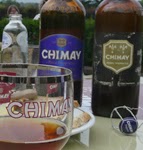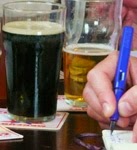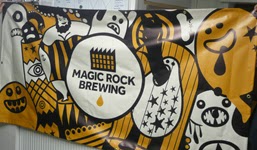St. Stefanus: an anagram of Augustijn?
On occasion, I get invited to various junkets - I mean, media opportunities. Usually in London, with 48 hours notice. Which means the original invitee either has gastric flu or a better offer elsewhere. So when I'm invited over to Ghent, Belgium on an all-expenses-paid jaunt for the launch of St Stefanus, I think straight away - who's taking the piss?
As it happens, this time, it was genuine. Which made it even more baffling. Why would I, a snot-nosed blathering blogger be invited along? Given that I don't buy into how bloggers are a PR's wet dream? Well, it seems what it took in this case was this: follow the brand on Twitter (but make no other contact with them), get an invite to Ghent by e-mail less than half an hour later.
To which I had to politely decline. Another event already booked in on that day, which I didn't even make it to by virtue of picking up a bug that gave me both-way evacuation-action for two solid - well, mainly liquid - days. But St Stefanus were kind enough to send me this box beforehand:
It looks good. Sturdy package, a booklet printed on heavyweight paper, attractive beer mats, a chalice glass and a couple of well-presented bottles. So I settled down to to read their, ahem, "brand story".
Sint Stefanus dates back to 1295. The Van Steenberge brewery dates back to 1784. The idea of brewing this beer dates back to, um, 1978, using a monastery yeast strain at the brewery. And then there are several attractive pages introducing the St Stefanus range.
So, what's been occurring for the last thirty-three years?
Well, it's been brewed. And it's been called Augustijn.
You may have drank Augustijn. The Blonde is one of those inoffensive, straightforward Belgian ales. The Dark has been around for a couple of years and, in the words to the Van Steenberge website, "ensures that the range of Augustijn-beers reflects a delicious spectrum of tastes within the rich Belgian beerculture".
So, are there a few pages missing from my "brand story"? After all, the Van Steenberge website is up front about the beer's heritage: "The brewery, which specialises in brewing refermentation beers, remains independent and will continue to produce and distribute in the local market under the original brand name of Augustijn. SABMiller has acquired the right to distribute the beer under the name of St Stefanus globally".
Which is not surprising. After all, AB-InBev has Leffe. Heineken has Grimbergen. What's a global brewer like SABMiller to do without an abbey brand? When I say 'abbey', I don't mean one designated by the Union of Belgian Brewers; I can't find any reference to Augustijn on the certified list. Whereas Leffe and Grimbergen are.
An average beer in expensive packaging with a mahoosive PR budget behind it. Buy why so coy about the Augustijn angle? I bet one of the Brit beer writers on the Ghent trip must have asked the question. I won't hold my breath for the answer, though...
As it happens, this time, it was genuine. Which made it even more baffling. Why would I, a snot-nosed blathering blogger be invited along? Given that I don't buy into how bloggers are a PR's wet dream? Well, it seems what it took in this case was this: follow the brand on Twitter (but make no other contact with them), get an invite to Ghent by e-mail less than half an hour later.
To which I had to politely decline. Another event already booked in on that day, which I didn't even make it to by virtue of picking up a bug that gave me both-way evacuation-action for two solid - well, mainly liquid - days. But St Stefanus were kind enough to send me this box beforehand:
It looks good. Sturdy package, a booklet printed on heavyweight paper, attractive beer mats, a chalice glass and a couple of well-presented bottles. So I settled down to to read their, ahem, "brand story".
Sint Stefanus dates back to 1295. The Van Steenberge brewery dates back to 1784. The idea of brewing this beer dates back to, um, 1978, using a monastery yeast strain at the brewery. And then there are several attractive pages introducing the St Stefanus range.
So, what's been occurring for the last thirty-three years?
Well, it's been brewed. And it's been called Augustijn.
You may have drank Augustijn. The Blonde is one of those inoffensive, straightforward Belgian ales. The Dark has been around for a couple of years and, in the words to the Van Steenberge website, "ensures that the range of Augustijn-beers reflects a delicious spectrum of tastes within the rich Belgian beerculture".
So, are there a few pages missing from my "brand story"? After all, the Van Steenberge website is up front about the beer's heritage: "The brewery, which specialises in brewing refermentation beers, remains independent and will continue to produce and distribute in the local market under the original brand name of Augustijn. SABMiller has acquired the right to distribute the beer under the name of St Stefanus globally".
Which is not surprising. After all, AB-InBev has Leffe. Heineken has Grimbergen. What's a global brewer like SABMiller to do without an abbey brand? When I say 'abbey', I don't mean one designated by the Union of Belgian Brewers; I can't find any reference to Augustijn on the certified list. Whereas Leffe and Grimbergen are.
An average beer in expensive packaging with a mahoosive PR budget behind it. Buy why so coy about the Augustijn angle? I bet one of the Brit beer writers on the Ghent trip must have asked the question. I won't hold my breath for the answer, though...























Never been very keen on Van Steenberge beers - there is soemthing about the house taste that doesn't quite appeal. The one exception is Wilson Mild Stout which is one of my secret beery vices.
ReplyDeleteHaving said that I think Augustijn has a bit more abut it than Leffe and a damn sight more than the Grimbgergen beers. Last time I tried them they were hugely disappointing.